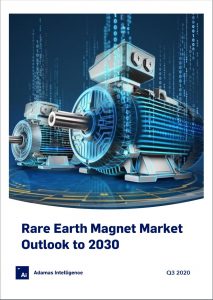U.S Mulling Game Changing Tax Credit for Rare Earth Magnets
Tabled with Bipartisan Support
Earlier this week, California Democrat Representative, Eric Swalwell, introduced a bill that would grant tax credits to domestic manufacturers of NdFeB magnets.
The bill, dubbed the Rare Earth Magnet Manufacturing Production Tax Credit Act, was co-sponsored by Pennsylvania Republican Representative, Guy Reschenthaler, giving it strong bipartisan support as it enters Congress.
The bill proposes a $20 per kilogram credit for NdFeB magnets made in the U.S., increasing to $30 per kilogram for NdFeB magnets made in the U.S. from domestically mined rare earths.
Adamas Intelligence’s Take
We are thrilled to see our recommendations come to light through this legislation. Over the past five years, Adamas has consistently conveyed to all levels of U.S. government its view that tax credits and/or tax relief are powerful levers that the U.S. can use to level the playing field for domestic producers while expediting the development of metals-, alloys- and magnet-making capacity.
This bill, if passed, would be a game changer for efforts to establish a modern mine-to-magnet supply chain in the U.S.
For low-temperature-grade NdFeB magnets, the proposed tax credit could cover the majority of NdPr metal input costs incurred by a magnet maker. For high-temperature-grade NdFeB magnets, the proposed credit could cover the majority of Fe-Dy and Tb input costs incurred.
In either case, the impact of a $20 to $30 per kilogram tax credit would be massive for U.S. manufacturers, particularly if vertically integrated from mine to magnet.
As the sole producer of rare earths in the U.S., MP Materials is well positioned to benefit from the bill. The company has been working towards re-establishing domestic rare earth processing operations in the U.S. and is aiming to unveil an initial metal, alloy and magnet production facility later this year.
USA Rare Earth and Urban Mining are two others with potential to capitalize on the new bill. USA Rare Earth is majority owner of the Round Top rare earth and critical minerals project in Texas, and also owns an NdFeB manufacturing system that it acquired from Hitachi Metals in 2020 that it plans to recommission next year. Similarly, Urban Mining, which currently produces NdFeB magnets from waste and recycled material in Texas, is also well-positioned to benefit as it scales up.
The Cost of Self Sufficiency
The U.S. currently imports around 400 to 500 tonnes of NdFeB magnets from China monthly. Under the proposed bill, reshoring this production could cost the nation’s taxpayers upwards of $150 million annually, and multiples more in the years ahead as U.S. demand for NdFeB magnets skyrockets under Biden’s new vehicle electrification plans.
However, the availability of U.S.-made magnets will foster the establishment of more domestic motor makers, wind turbine manufacturers, electronics manufacturers and other end-users reliant on a steady and predictable supply of magnets in the years ahead, fueling job creation and economic growth that would easily offset credits given to magnet makers.
More Information: Rare Earth Magnet Market Outlook to 2030
In this report, we provide a detailed overview of the global NdFeB alloy, powder, magnet and magnet rare earth markets, including a historical breakdown of production, consumption, prices and inventory levels from 2015 through 2019. Next, we unravel the anticipated near-term impact of the COVID-19 pandemic on world markets and forecast global supply, demand and prices from 2020 through 2030.

Back to overview


